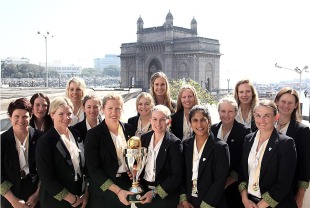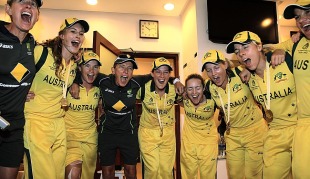The Women's World Cup, 2012-13
Alison Mitchell

|
|||
|
Related Links
Series/Tournaments:
ICC Women's World Cup
Teams:
Australia
| England
| India
| New Zealand
| Pakistan
| South Africa
| Sri Lanka
| West Indies
|
|||
In 40 years of the women's World Cup, the traditional powerhouses of Australia, England, New Zealand and - to a lesser extent - India have rarely been challenged. But the tenth edition brought a significant shift: an emergent Sri Lanka upset two of the top nations, ensuring an early exit for hosts India, while the mercurial West Indies reached their first final. The shift did not prove seismic, however: Australia lifted the trophy for a record sixth time, adding it to the World Twenty20 they had won in Colombo four months earlier.
The tournament was memorable for a higher standard of play from a greater number of teams, several tight finishes, a record number of World Cup centuries, pitches conducive to entertaining cricket, and an audience from over 150 territories watched the ten televised matches. But there were complications, including doubts over whether the Pakistan team could stay safely in Mumbai, the host city: Indo-Pakistani tensions had recently led to right-wing political protests, forcing Pakistani hockey players out of the Mumbai Magicians squad. And once Mumbai's male cricketers made the final of the Ranji Trophy, they declared they wanted to play it at the Wankhede Stadium, their home ground, which had been earmarked as one of the World Cup's main venues.
When the Wankhede was duly withdrawn by the BCCI on January 21, ten days before the opening match, it was regarded as a snub to the women's game. The nearby Brabourne Stadium became the central venue for all televised games, including the final. As it transpired, the smaller ground - home of the Cricket Club of India - was well suited to the tournament: dripping with history, it offered a more intimate experience for players and spectators.
As for Pakistan, it was decided that an additional host city was needed. India, England, Sri Lanka and West Indies made up Group A in Mumbai, while Australia, New Zealand, Pakistan and South Africa contested Group B, roughly a thousand miles away in Cuttack. Pakistan were forced to stay in the Barabati Stadium's academy accommodation - officially for security reasons, though it was understood some hotels were reluctant to take them. The revised schedule was confirmed only six days before the tournament began. It followed the same format as in 2008-09: the top three teams from each group of four would qualify for the Super Sixes, from which the top two would contest the final.
Once the cricket got under way, it was captivating. In the opening match, Thirush Kamini became the first Indian woman to hit a century in a World Cup (a pity there was only one half-full stand to see it). A 22-year-old left-hander from Chennai, Kamini was playing her first one-day international in three years. After a steady start, she stroked her way to a rousing 100 off 146 balls, lofting the first six of the tournament over deep midwicket, as India demolished West Indies by 105 runs. It was to be the first of 11 centuries - almost twice as many as at any other World Cup - including two more for India and two from England captain Charlotte Edwards, who passed Belinda Clark to become the all-time leading scorer in women's one-day internationals.

|
|||
On the morning of the first match, The Times of India had devoted almost the whole front page of their sport section to India's chances, together with profiles of key players. And media coverage gathered pace after Kamini's hundred. But it was not to last. A loss to England, followed by a surprise 138-run defeat by Sri Lanka, meant India did not qualify for the Super Sixes, and the wave of support receded. No more Bollywood actors or wives of IPL owners would be seen at the World Cup. A century for captain Mithali Raj and victory over arch-rivals Pakistan in the seventh-place play-off in Cuttack were scant consolation; the BCCI bore the brunt of media criticism for failing to support the women's game sufficiently.
Sri Lanka's win over India was their second major upset. They had arrived as the second-lowest ranked side, having failed to win a single fixture at the previous World Cup. Yet the introduction of match fees, and contracts to play for the Armed Forces had already helped them stage the biggest upset in the tournament's history: a thrilling one-wicket win off the last ball against defending champions England.
That game marked Eshani Kaushalya's coming of age. Playing in her third World Cup as a medium-pace all-rounder, she batted with a swagger and a stance reminiscent of compatriot Sanath Jayasuriya - and hit the ball almost as hard. With 86 still needed at a run a ball, she crashed 56 off 41 and took her team to the brink. Sri Lanka had never beaten England or India before and, although they possessed bowling talent as well as batting, defeat by West Indies illustrated a damaging inconsistency. Three losses followed in the Super Sixes, including one by 110 runs to South Africa, though they went on to beat them by 88 runs in the fifth-place play-off.
Inconsistency was also the scourge of West Indies, who sneaked through the group on net run-rate, yet won all three Super Six matches, including an unlikely victory over Australia, to reach their first World Cup final and consign a disgruntled England to the third-place play-off against New Zealand. Allrounder Deandra Dottin's reputation preceded her - she had made a 38-ball hundred in the World Twenty20 of 2010 - and she now delivered the fastest recorded fifty in women's international cricket: a blistering half-century in 20 deliveries to help brush aside Sri Lanka. West Indies' total of 368 for eight, a team record, was built around Stafanie Taylor's career-best 171 off 137 balls. Australia were unbeaten until their surprise loss to West Indies in the Super Sixes. Their batting faltered at times, though it was at its best when they beat New Zealand in a group game. The New Zealanders had looked like the form side until they too lost to West Indies in the Super Sixes. Captain Suzie Bates was in particularly good touch, and was the tournament's leading run-scorer with 407, including 102 against Australia. England's highly regarded wicketkeeper-batter, Sarah Taylor, had a poor start, missing the first game through injury and later racking up three successive ducks. That nearly became four: she was dropped on nought in the last Super Six match, against New Zealand, before going on to a sparkling 88 off 79 balls. But it was too little too late, as news filtered through of West Indies' win over Australia.
Australia possessed the tournament's leading wicket-taker, pace bowler Megan Schutt from Adelaide, who took 15 scalps at 16 apiece. They had to cope with the loss of star bowler Ellyse Perry in the middle of the tournament through injury: forced out of their first Super Six fixture, against England, she could not play again until the final. But it meant the door opened for another tall, blonde fast bowler. Holly Ferling, a 17-year-old Queenslander who had made her international debut a week earlier, bowled quickly, if not always accurately, with the exuberance of youth and a white ribbon holding in place her long ponytail.
Perry returned for the final, despite what was later diagnosed as a stress fracture in her left ankle. After a scare when she twice aborted her run-up, she found her rhythm to take three for 19 as Australia successfully defended their 259 for seven, the highest total in a women's World Cup final. All-rounder Lisa Sthalekar bowled a miserly spell of two for 20 and took a stunning diving catch to seal victory, before announcing her retirement from international cricket, aged 33. The captaincy of Jodie Fields was superb throughout.
Despite large TV audiences, attendances in Mumbai in particular were low. There was no World Cup branding in the streets or indeed at the three grounds. At the Brabourne, a single hoarding at the entrance gates signposted the World Cup. A few months earlier, when the women's World Twenty20 was held in Sri Lanka alongside the men's, there had been life-size cardboard cut-outs of star women players in airport arrival halls or perched on roundabouts. The ICC, running their second World Cup after taking charge of the women's international game in 2005, preferred to focus their marketing campaign online.
But it did not have the desired effect. The standard of umpiring was disappointing. There was no official from the ICC's Elite Panel; in the previous tournament, the highly respected Steve Davis had mentored the other umpires and stood in three matches, including the final. The format was also questioned, with suggestions that teams should have carried through all points gained from the group stage, instead of only those gained against other teams who had qualified for the Super Sixes. Players said privately that they would have enjoyed national anthems at the start of every match, as in 2008-09, instead of the final alone. The World Cup is the pinnacle of every player's career, and anthems would have added to the sense of occasion at a tournament where the cricket repeatedly hit the high notes.
Match reports for
1st Match, Group A: India Women v West Indies Women at Brabourne, Jan 31, 2013
Scorecard
2nd Match, Group B: Australia Women v Pakistan Women at Cuttack, Feb 1, 2013
Scorecard
3rd Match, Group A: England Women v Sri Lanka Women at Brabourne, Feb 1, 2013
Scorecard
4th Match, Group B: New Zealand Women v South Africa Women at Cuttack, Feb 1, 2013
Scorecard
5th Match, Group B: Australia Women v South Africa Women at Cuttack, Feb 3, 2013
Scorecard
6th Match, Group A: India Women v England Women at Brabourne, Feb 3, 2013
Scorecard
7th Match, Group B: New Zealand Women v Pakistan Women at Cuttack, Feb 3, 2013
Scorecard
8th Match, Group A: Sri Lanka Women v West Indies Women at Mumbai, Feb 3, 2013
Scorecard
9th Match, Group B: Australia Women v New Zealand Women at Cuttack, Feb 5, 2013
Scorecard
10th Match, Group A: England Women v West Indies Women at Mumbai, Feb 5, 2013
Scorecard
11th Match, Group B: Pakistan Women v South Africa Women at Cuttack, Feb 5, 2013
Scorecard
12th Match, Group A: India Women v Sri Lanka Women at Brabourne, Feb 5, 2013
Scorecard
7th Place Play-off: India Women v Pakistan Women at Cuttack, Feb 7, 2013
Scorecard
13th Match, Super Six: Australia Women v England Women at Brabourne, Feb 8, 2013
Scorecard
14th Match, Super Six: New Zealand Women v Sri Lanka Women at Mumbai, Feb 8, 2013
Scorecard
15th Match, Super Six: South Africa Women v West Indies Women at Cuttack, Feb 8, 2013
Scorecard
16th Match, Super Six: Australia Women v Sri Lanka Women at Brabourne, Feb 10, 2013
Scorecard
17th Match, Super Six: England Women v South Africa Women at Cuttack, Feb 10, 2013
Scorecard
18th Match, Super Six: New Zealand Women v West Indies Women at Brabourne, Feb 11, 2013
Scorecard
19th Match, Super Six: Australia Women v West Indies Women at Mumbai, Feb 13, 2013
Scorecard
20th Match, Super Six: South Africa Women v Sri Lanka Women at Cuttack, Feb 13, 2013
Scorecard
21st Match, Super Six: England Women v New Zealand Women at Brabourne, Feb 13, 2013
Scorecard
3rd Place Play-off: England Women v New Zealand Women at Brabourne, Feb 15, 2013
Scorecard
5th Place Play-off: South Africa Women v Sri Lanka Women at Cuttack, Feb 15, 2013
Scorecard
Final: Australia Women v West Indies Women at Brabourne, Feb 17, 2013
Scorecard

